sklearn.datasets.make_classification
官方地址:
https://www.w3cschool.cn/doc_scikit_learn/scikit_learn-modules-generated-sklearn-datasets-make_classification.html
sklearn.datasets.make_classification(n_samples=100, n_features=20, n_informative=2, n_redundant=2, n_repeated=0, n_classes=2, n_clusters_per_class=2, weights=None, flip_y=0.01, class_sep=1.0, hypercube=True, shift=0.0, scale=1.0, shuffle=True, random_state=None) [source]
一、过采样与欠采样原理
在进行数据分析建模的过程中,数据不均衡是非常常见的问题,一般可以用过采样,欠采样,过采样+欠采样等发放处理。过采样一般包括随机过采样、插值Smote和KNN分类器的Adasyn;欠采样一般包括随机欠采样、EasyEnsemble、BalanceCascade、NearMiss、Tomek Link、Edited Nearest Neighbours (ENN)等。
过采样,又称上采样(over-sampling),通过增加分类中少数类样本的数量来实现样本均衡。
如SMOTE算法,通过插值生成合成样本,非直接对少数类进行重采样,从而使得少数类样本的特征空间得到扩展,有助于模型更好地探索和学习少数类的特征,提高模型的性能。其主要步骤如下:
- 在少数类样本中随机选一个样本
- 找到该样本的K个近邻(假设K = 5)
- 随机从K个近邻中选出一个样本
- 在该样本和随机选出的这个近邻样本之间的连线上,随机找一点,即是人工合成的新样本
- 重复上述步骤,生成指定数量的合成样本
欠采样,又称下采样(under-sampling),其通过减少分类中多数类样本的数量来实现样本均衡。
如随机欠采样,随机从多数类样本中抽取一部分数据进行删除,随机欠采样有一个很大的缺点是未考虑样本的分布情况,而采样过程又具有很大的随机性,可能会误删多数类样本中一些重要的信息。
二、代码示例
# -*- coding: utf-8 -*-
import numpy as np
from imblearn.over_sampling import SMOTE
from imblearn.over_sampling import RandomOverSampler
from imblearn.over_sampling import ADASYN
from imblearn.under_sampling import RandomUnderSampler
from imblearn.under_sampling import NearMiss
from sklearn.datasets import make_classification
# 随机生成原始数据
x, y = make_classification(n_samples=1000, n_features=5, n_classes=2,
weights=[0.1, 0.9], random_state=123)
print('原始正样本数:', np.sum(y == 1), '原始负样本数:', np.sum(y == 0), '原始总数:', len(x))
# smote过采样
smote = SMOTE()
x_new, y_new = smote.fit_resample(x, y)
print('smote后正样本数:', np.sum(y_new == 1), 'smote后负样本数:', np.sum(y_new == 0), 'smote后总数:', len(x_new))
# 随机欠采样
rus = RandomUnderSampler()
x_new2, y_new2 = rus.fit_resample(x, y)
print('随机欠采样后正样本数:', np.sum(y_new2 == 1), '随机欠采样后负样本数:', np.sum(y_new2 == 0), '随机欠采样后总数:', len(x_new2))
结果展示:
附录
=================================================
make_classification分类函数参数
1.n_samples:int, optional (default=100)
样本的数量
2.n_features:int, optional (default=20)
样本的特征数
3.n_informative:int, optional (default=2)
样本中有用的特征数量。这个参数只有当数据集的分类数为2时才有效
4.n_redundant:int, optional (default=2)
样本中冗余特征的数量,这些特征是从有用特征中随机组合而成的
5.n_repeated: int,int, optional (default=0)
从信息特征和冗余特征中随机抽取的重复特征的数量。
6.n_classes:int, optional (default=2)
数据集分类的数量
7.n_clusters_per_class: int, optional (default=2)
每个类的簇数。
8.weights : list of floats or None (default=None)
分配给每个类别的样本比例。如果无,则类是平衡的。请注意,如果len(weights)=n_classes-1,则会自动推断出最后一个类的权重。如果权重之和超过1,则可以返回多于n_samples的样本。
9.flip_y : float, optional (default=0.01)
类被随机交换的样本的分数。文章来源:https://www.toymoban.com/news/detail-838036.html
10.random_state:int, RandomState instance or None, optional (default=None)
随机数的种子文章来源地址https://www.toymoban.com/news/detail-838036.html
到了这里,关于数据不平衡处理方式之过采样和欠采样(Python代码)的文章就介绍完了。如果您还想了解更多内容,请在右上角搜索TOY模板网以前的文章或继续浏览下面的相关文章,希望大家以后多多支持TOY模板网!












